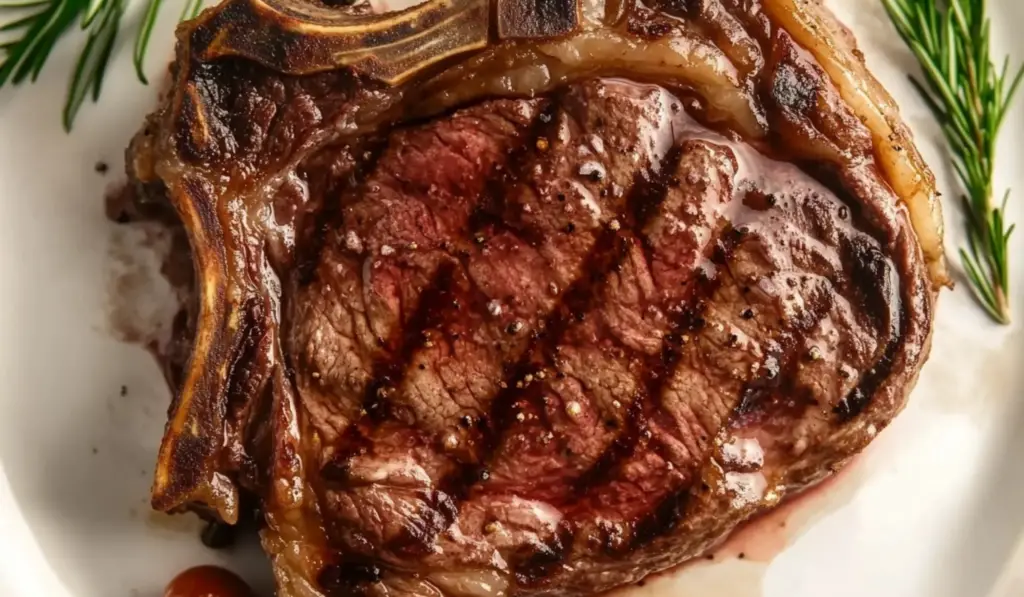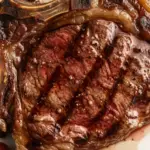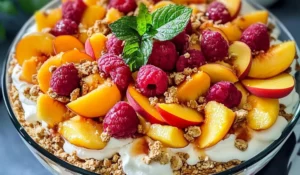Ribeye steaks are an undeniable favorite among steak lovers, celebrated for their rich marbling, incredible tenderness, and mouthwatering juiciness. Known for their delicious beefy flavor, ribeye steaks stand out among other cuts of beef due to the abundant marbling of fat throughout the meat, which melts as it cooks, infusing the steak with a burst of savory goodness. The tender, juicy texture and robust flavor profile make ribeye steaks a prime choice for home cooks and professional chefs alike. Whether you’re grilling, pan-searing, or oven-roasting, ribeye steaks offer a mouthwatering experience that’s hard to beat. With this step-by-step recipe, you’ll be able to create ribeye steaks that are perfectly cooked, every single time—making you feel like a seasoned pro in the kitchen.
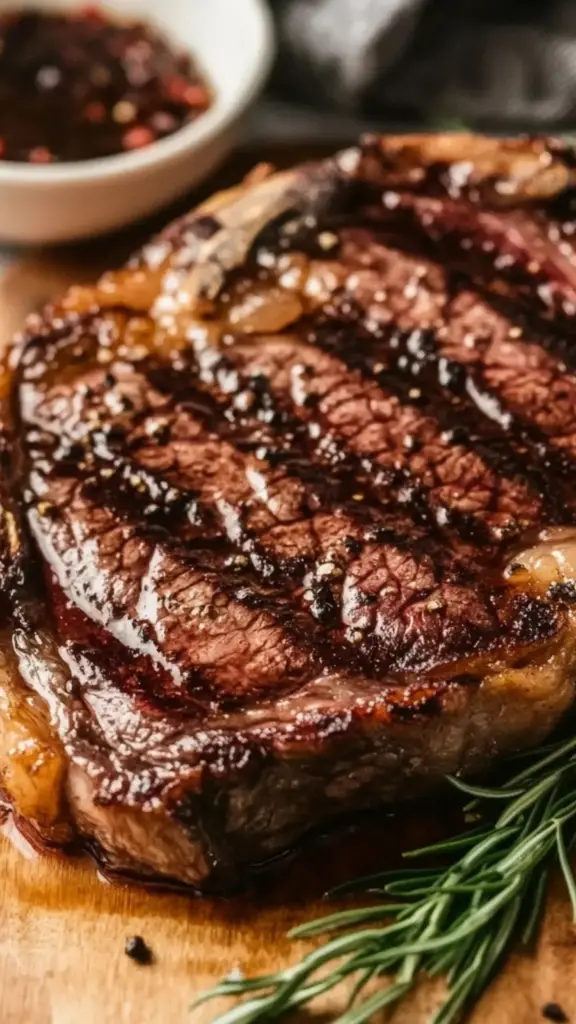
Perfect Ribeye Steaks: A Flavorful and Tender Delight
Ribeye steaks are an undeniable favorite among steak lovers, celebrated for their rich marbling, incredible tenderness, and mouthwatering juiciness. Known for their delicious beefy flavor, ribeye steaks stand out among other cuts of beef due to the abundant marbling of fat throughout the meat, which melts as it cooks, infusing the steak with a burst of savory goodness. The tender, juicy texture and robust flavor profile make ribeye steaks a prime choice for home cooks and professional chefs alike. Whether you’re grilling, pan-searing, or oven-roasting, ribeye steaks offer a mouthwatering experience that’s hard to beat. With this step-by-step recipe, you’ll be able to create ribeye steaks that are perfectly cooked, every single time—making you feel like a seasoned pro in the kitchen.
- Prep Time: 5 minutes
- Cook Time: 15 minutes
- Total Time: 30 minutes
- Yield: 2 steaks 1x
- Category: Main Dish
- Method: Grilling, Oven
- Cuisine: American
- Diet: Gluten Free
Ingredients
- 2 ribeye steaks, 1-inch thick
- 2 tablespoons olive oil (or vegetable oil, your choice)
- 1 tablespoon steak seasoning (or kosher salt and pepper, to taste)
- 2 tablespoons butter (or herbed butter for extra richness)
Instructions
1. Preparation is Key
Before you even start cooking, it’s important to let your steaks come to room temperature. This is a crucial step in achieving a perfect ribeye steak. Remove the steaks from the fridge at least 45 minutes before cooking. If you place cold steaks straight onto a hot grill or pan, they will cook unevenly. Allowing the steaks to rest at room temperature ensures a consistent cook from the outside in, so that the meat stays juicy and tender throughout.
While the steaks are coming to room temperature, gather the remaining ingredients and get ready to season them just before cooking.
2. Seasoning the Steaks
Seasoning is one of the most important steps in cooking a ribeye steak. The goal is to enhance the natural flavor of the beef, not overpower it. For the most straightforward and delicious flavor, rub the steaks with olive oil or vegetable oil. This helps the seasoning stick to the meat and contributes to the beautiful sear that develops during cooking.
Generously season the steaks with steak seasoning, or if you prefer a more classic approach, kosher salt and freshly cracked black pepper. The seasoning should coat both sides of the steaks. Depending on your preferences, you can adjust the seasoning to taste, but keep in mind that a generous application helps bring out the natural flavors of the ribeye. This seasoning step will allow the beef’s rich, savory flavor to shine, creating that mouthwatering taste with every bite.
3. Grilling Method: For the Smoky Flavor
Grilling ribeye steaks adds a smoky depth of flavor that makes them irresistible. To get started, preheat the grill to medium heat, aiming for a temperature around 375°F. Make sure the grill grates are clean to ensure the steaks don’t stick and achieve a perfect sear.
Once your grill is preheated and the steaks are seasoned, place the steaks on the grill. Grill each side for 5-6 minutes for medium-rare or 6-7 minutes for medium. These times are approximate and will vary depending on the thickness of the steak and the heat of the grill. For reference, medium-rare is typically the preferred doneness for ribeye steaks, as it allows the marbled fat to melt, making the steak juicy and tender.
As the steaks cook, resist the urge to press down on them with your spatula or tongs—this will only release juices and make the steak less flavorful. Instead, let the steaks sear undisturbed for the best results. After grilling, remove the steaks from the heat and immediately top them with a pat of butter. You can use regular butter or herbed butter to add a rich, aromatic flavor. Loosely tent the steaks with aluminum foil to keep the heat in while they rest. Resting the steaks for about 5-10 minutes allows the juices to redistribute, ensuring a tender and juicy steak with every bite.
4. Oven Method: For a Hands-Off Approach
If you prefer to cook your ribeye steaks in the oven, this method is ideal for a more controlled cooking process. First, preheat your oven to 400°F. While the oven is heating, prepare a large cast-iron pan by placing it on the stove over medium-high heat. Cast-iron skillets are perfect for this recipe because they retain heat well and create a beautiful sear.
Once the pan is hot, add the steaks and sear them for 2 minutes on each side. This will give the steaks a lovely browned crust. After the searing is done, carefully transfer the pan to the preheated oven. Roast the steaks for 11-14 minutes or until they reach your desired doneness. The oven method allows you to cook the steaks more evenly, especially if you prefer your ribeyes cooked through without the risk of burning them on the grill. When the steaks are done, remove them from the oven and place them on a plate to rest. As with the grilling method, top them with a pat of butter, tent them with foil, and let them rest for 5-10 minutes before serving.
5. Achieving the Perfect Temperature
The perfect ribeye steak is all about timing. To help you achieve the ideal doneness, here are some approximate internal temperature ranges for different levels of doneness. Remember to use a meat thermometer to check the internal temperature of your steak before removing it from the heat:
- Rare: 125°F
- Medium-Rare: 135°F
- Medium: 145°F
- Medium-Well: 155°F
- Well-Done: 160°F
For the most accurate results, remove the steaks from the heat when they are about 5°F below your desired temperature, as the meat will continue to cook from residual heat while it rests. The FDA recommends a minimum internal temperature of 145°F for beef, with a 3-minute rest time for optimal results.
Notes
Seasoning Variations
If you want to add more complexity to the flavor of your steak, consider experimenting with different seasonings. You can add garlic powder, onion powder, smoked paprika, or even cayenne pepper for a bit of heat. Fresh herbs like rosemary or thyme can be rubbed onto the steaks before cooking to add a fragrant, herby touch. Additionally, try adding a splash of Worcestershire sauce or a sprinkle of Parmesan cheese to elevate the flavor.
Butter Variations
For an extra burst of flavor, use herbed butter instead of plain butter. Simply mix softened butter with chopped fresh herbs such as parsley, thyme, oregano, or rosemary. Adding a touch of garlic or lemon zest to the butter will also enhance the overall taste of the steak.
Serving Suggestions
Ribeye steaks are incredibly versatile and can be paired with a wide range of side dishes. For a classic steakhouse dinner, serve the ribeye with mashed potatoes, sautéed spinach, grilled vegetables, or a side salad. For a twist, try pairing your ribeye with roasted sweet potatoes, creamy mac and cheese, or even a baked potato topped with sour cream and chives.
A glass of red wine, such as a full-bodied Cabernet Sauvignon, Merlot, or Malbec, will pair beautifully with the rich flavors of the ribeye. If you prefer a non-alcoholic option, serve the steak with a refreshing iced tea or a sparkling water with a squeeze of lemon.
Leftovers
If you have leftover ribeye steak, don’t let it go to waste! Slice the leftover steak thinly and use it for steak sandwiches, steak salads, or wraps. The leftover juices can be drizzled over the sliced steak to retain its moisture and flavor. Leftover ribeye can also be used in tacos or steak fajitas for a quick and easy meal the next day.
This recipe breaks down the process into simple, easy-to-follow steps, ensuring that even beginners can make a restaurant-quality ribeye steak. From preparation to seasoning and cooking, each stage plays a vital role in achieving the perfect steak. Whether you choose to cook your steaks on the grill or in the oven, you’ll get that beautifully seared crust on the outside, while the inside remains juicy and tender. The addition of butter at the end creates a luscious finish that elevates the flavor even further. Whether you’re cooking for yourself, your family, or a dinner party, these ribeye steaks will impress.
Ingredients
Before you get started, make sure you have everything you need for this delicious recipe. The ingredients are simple, but they bring out the natural flavor of the ribeye steak in the most satisfying way:
- 2 ribeye steaks, 1-inch thick
- 2 tablespoons olive oil (or vegetable oil, your choice)
- 1 tablespoon steak seasoning (or kosher salt and pepper, to taste)
- 2 tablespoons butter (or herbed butter for extra richness)
These ingredients are all you need to create a mouthwatering ribeye steak, but feel free to get creative with the seasoning and butter for extra flavor.
Instructions
Follow these steps to create the most tender and flavorful ribeye steaks you’ve ever tasted. Whether you’re grilling your steaks to perfection or using an oven for a more hands-off approach, the process is simple and results in an absolutely delicious meal.
1. Preparation is Key
Before you even start cooking, it’s important to let your steaks come to room temperature. This is a crucial step in achieving a perfect ribeye steak. Remove the steaks from the fridge at least 45 minutes before cooking. If you place cold steaks straight onto a hot grill or pan, they will cook unevenly. Allowing the steaks to rest at room temperature ensures a consistent cook from the outside in, so that the meat stays juicy and tender throughout.
While the steaks are coming to room temperature, gather the remaining ingredients and get ready to season them just before cooking.
2. Seasoning the Steaks
Seasoning is one of the most important steps in cooking a ribeye steak. The goal is to enhance the natural flavor of the beef, not overpower it. For the most straightforward and delicious flavor, rub the steaks with olive oil or vegetable oil. This helps the seasoning stick to the meat and contributes to the beautiful sear that develops during cooking.
Generously season the steaks with steak seasoning, or if you prefer a more classic approach, kosher salt and freshly cracked black pepper. The seasoning should coat both sides of the steaks. Depending on your preferences, you can adjust the seasoning to taste, but keep in mind that a generous application helps bring out the natural flavors of the ribeye. This seasoning step will allow the beef’s rich, savory flavor to shine, creating that mouthwatering taste with every bite.
3. Grilling Method: For the Smoky Flavor
Grilling ribeye steaks adds a smoky depth of flavor that makes them irresistible. To get started, preheat the grill to medium heat, aiming for a temperature around 375°F. Make sure the grill grates are clean to ensure the steaks don’t stick and achieve a perfect sear.
Once your grill is preheated and the steaks are seasoned, place the steaks on the grill. Grill each side for 5-6 minutes for medium-rare or 6-7 minutes for medium. These times are approximate and will vary depending on the thickness of the steak and the heat of the grill. For reference, medium-rare is typically the preferred doneness for ribeye steaks, as it allows the marbled fat to melt, making the steak juicy and tender.
As the steaks cook, resist the urge to press down on them with your spatula or tongs—this will only release juices and make the steak less flavorful. Instead, let the steaks sear undisturbed for the best results. After grilling, remove the steaks from the heat and immediately top them with a pat of butter. You can use regular butter or herbed butter to add a rich, aromatic flavor. Loosely tent the steaks with aluminum foil to keep the heat in while they rest. Resting the steaks for about 5-10 minutes allows the juices to redistribute, ensuring a tender and juicy steak with every bite.
4. Oven Method: For a Hands-Off Approach
If you prefer to cook your ribeye steaks in the oven, this method is ideal for a more controlled cooking process. First, preheat your oven to 400°F. While the oven is heating, prepare a large cast-iron pan by placing it on the stove over medium-high heat. Cast-iron skillets are perfect for this recipe because they retain heat well and create a beautiful sear.
Once the pan is hot, add the steaks and sear them for 2 minutes on each side. This will give the steaks a lovely browned crust. After the searing is done, carefully transfer the pan to the preheated oven. Roast the steaks for 11-14 minutes or until they reach your desired doneness. The oven method allows you to cook the steaks more evenly, especially if you prefer your ribeyes cooked through without the risk of burning them on the grill. When the steaks are done, remove them from the oven and place them on a plate to rest. As with the grilling method, top them with a pat of butter, tent them with foil, and let them rest for 5-10 minutes before serving.
5. Achieving the Perfect Temperature
The perfect ribeye steak is all about timing. To help you achieve the ideal doneness, here are some approximate internal temperature ranges for different levels of doneness. Remember to use a meat thermometer to check the internal temperature of your steak before removing it from the heat:
- Rare: 125°F
- Medium-Rare: 135°F
- Medium: 145°F
- Medium-Well: 155°F
- Well-Done: 160°F
For the most accurate results, remove the steaks from the heat when they are about 5°F below your desired temperature, as the meat will continue to cook from residual heat while it rests. The FDA recommends a minimum internal temperature of 145°F for beef, with a 3-minute rest time for optimal results.
Flavor, Texture, and Aroma
When cooked to perfection, ribeye steaks are a symphony of flavors, textures, and aromas. The marbling of fat in a ribeye steak ensures that the meat remains juicy and tender, with each bite offering a satisfying combination of richness and depth. As the fat melts during cooking, it imparts a delicious flavor throughout the steak, making it incredibly juicy and full of savory goodness.
The texture of a ribeye is tender yet firm, offering a satisfying bite without being too chewy or too soft. The outside of the steak should develop a beautiful, crispy crust that contrasts perfectly with the moist, flavorful interior. The aroma of the steak as it cooks is irresistible, filling your kitchen with the mouthwatering scent of sizzling beef. The rich, savory scent of the searing steak is enough to make anyone’s mouth water in anticipation.
When you slice into a perfectly cooked ribeye, the steak should be tender enough to cut with ease, while still offering enough resistance for a satisfying chew. The juices that collect on the cutting board are a sure sign that the steak has been properly rested and cooked to perfection. The combination of tender meat and flavorful fat is what makes the ribeye steak such a popular choice among steak enthusiasts.
Tips for Ingredient Substitutions, Variations, and Serving Suggestions
While the basic ingredients in this recipe are simple and effective, there are many ways to customize it to your taste.
Seasoning Variations
If you want to add more complexity to the flavor of your steak, consider experimenting with different seasonings. You can add garlic powder, onion powder, smoked paprika, or even cayenne pepper for a bit of heat. Fresh herbs like rosemary or thyme can be rubbed onto the steaks before cooking to add a fragrant, herby touch. Additionally, try adding a splash of Worcestershire sauce or a sprinkle of Parmesan cheese to elevate the flavor.
Butter Variations
For an extra burst of flavor, use herbed butter instead of plain butter. Simply mix softened butter with chopped fresh herbs such as parsley, thyme, oregano, or rosemary. Adding a touch of garlic or lemon zest to the butter will also enhance the overall taste of the steak.
Serving Suggestions
Ribeye steaks are incredibly versatile and can be paired with a wide range of side dishes. For a classic steakhouse dinner, serve the ribeye with mashed potatoes, sautéed spinach, grilled vegetables, or a side salad. For a twist, try pairing your ribeye with roasted sweet potatoes, creamy mac and cheese, or even a baked potato topped with sour cream and chives.
A glass of red wine, such as a full-bodied Cabernet Sauvignon, Merlot, or Malbec, will pair beautifully with the rich flavors of the ribeye. If you prefer a non-alcoholic option, serve the steak with a refreshing iced tea or a sparkling water with a squeeze of lemon.
Leftovers
If you have leftover ribeye steak, don’t let it go to waste! Slice the leftover steak thinly and use it for steak sandwiches, steak salads, or wraps. The leftover juices can be drizzled over the sliced steak to retain its moisture and flavor. Leftover ribeye can also be used in tacos or steak fajitas for a quick and easy meal the next day.
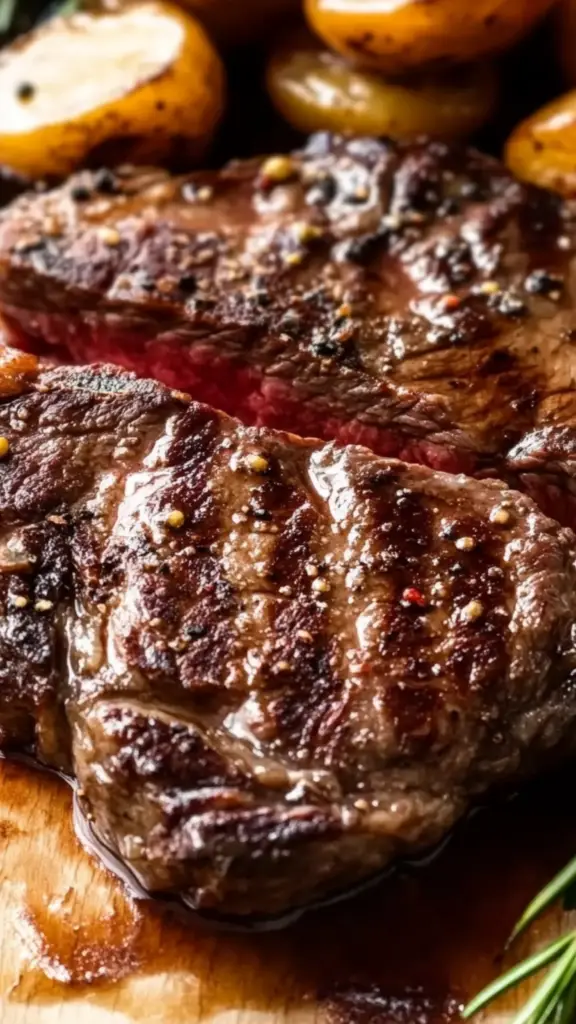
Final Thoughts
This recipe for perfect ribeye steaks is your guide to creating a mouthwatering steak dinner that’s sure to impress. Whether you grill, pan-sear, or roast the steaks, you’ll achieve that perfect balance of rich, beefy flavor, juicy tenderness, and a crispy, flavorful crust. Ribeye steaks are a classic favorite for a reason, and this recipe allows you to bring that steakhouse-quality experience into your own home. The simple ingredients and easy-to-follow steps ensure that even beginner cooks can create a steak that will make everyone at the table rave.
Enjoy your perfect ribeye steaks, and savor every delicious bite!
